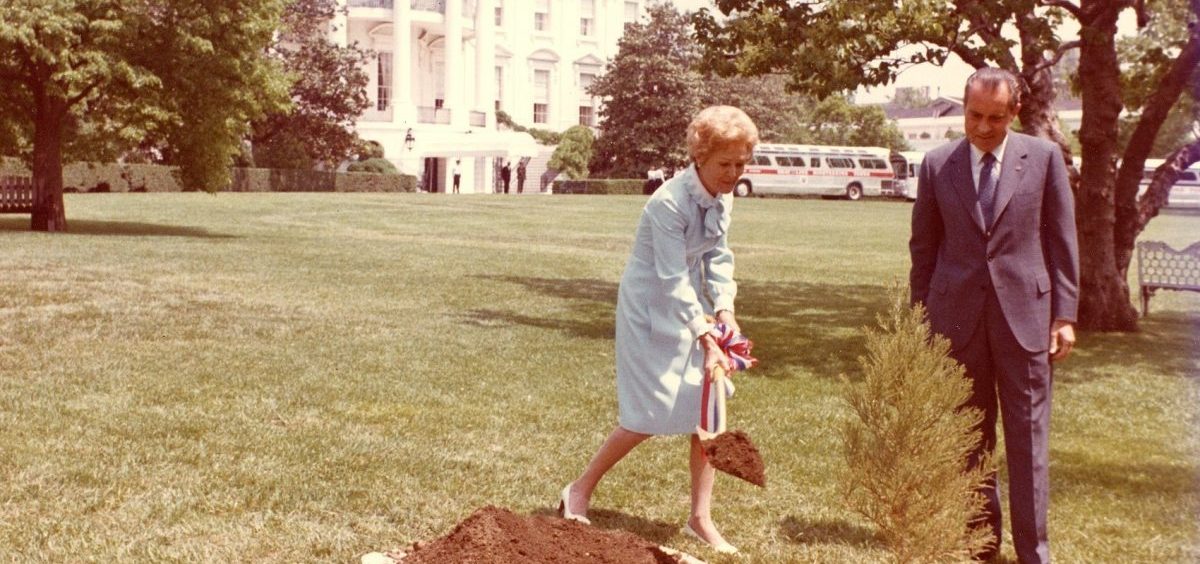News

Earth Day At 50: Climate Activists Go Digital Amid Pandemic Shutdown
By: Jeff Brady | NPR
Posted on:
Updated at 12:30 p.m. ET
Former President Richard Nixon celebrated the first Earth Day in 1970 by planting a tree on the White House South Lawn. An enormous turnout of some 20 million people across the country attended Earth Day festivities, putting the fight against pollution on the political agenda.
That year Nixon created the Environmental Protection Agency, and went on to sign the Clean Water Act and Clean Air Act with broad bipartisan support.
50 years later, the biggest environmental challenge is climate change, something most had never heard about back in 1970.
But large gatherings are not possible amid the global coronavirus pandemic, so Earth Day has moved online. Millions of people around the world are expected to take part in the anniversary of what organizers call “the largest secular observance in the world.”
President Trump and the First Lady also took part in a tree planting ceremony at the White House today. In his Earth Day message, Trump did not mention climate change, though he did tout the U.S. a world leader in reducing “energy-related carbon dioxide emissions.” At times in the past, Trump has denounced climate change as a hoax.
On the eve of this year’s anniversary, Trump directed his administration to work on a financial aid plan for the oil and gas industry, which has been hit hard by global shutdowns to address the pandemic.
“The oil and gas industry spent millions to elect Trump in 2016, and they’re getting exactly what they paid for,” responded Greenpeace USA Senior Climate Campaigner Jack Shapiro. He thinks that “not a cent of taxpayer money should go to the corporations that created and profited from the climate crisis.”
It’s not yet clear exactly what financial help the Trump administration plans to give oil companies.
“Critical turning point”
“We originally envisioned [this] Earth Day as a really critical turning point for the movement,” says Naina Agrawal-Hardin, a 17-year-old high school junior from Ann Arbor, Michigan.
She is one of the young climate change activists the world has heard a lot from over the last year-and-a-half as they organized a series of school climate strikes.
They’ve been galvanized by a series of scientific reports warning that the world must dramatically reduce carbon emissions, and soon, if it hopes to avoid the most catastrophic climate impacts.
“Obviously now our plans have had to pivot. We cannot have millions of people in the streets,” says Agrawal-Hardin. She’s working with a coalition of 500 organizations that organized three days of online events, including teach-ins, virtual protests and a campaign to encourage young people to vote in November.
A group called Earth Day Network plans “24 hours of action” that invites digital activists to participate in hourly campaigns “to demand action and drive change.”
Before the coronavirus pandemic the group had much bigger plans.
“For two years, the Earth Day Network patiently laid the groundwork for gigantic crowds in 180 nations,” wrote Denis Hayes in the Seattle Times. He organized the first Earth Day and founded the Earth Day Network.
“The goal was to build an irresistible worldwide force to demand a global Green New Deal and, ultimately, solve the climate crisis,” wrote Hayes. Instead he’s encouraging people to stay home this year, participate in virtual activities and “vote for the earth” in November.
Conservative climate change activists also have moved their plans online. Kiera O’Brien was scheduled to speak about attracting young conservatives to the climate movement at the EarthX conference in Dallas.
“I’m still speaking at EarthX, but the speeches will now be spread out across the summer,” says O’Brien, who founded and is president of Young Conservatives for Carbon Dividends.
She plans to spend Earth Day watching the conference live-stream from her home in Alaska.
O’Brien says she’s optimistic that despite a much different Earth Day than many were expecting, the U.S. economy will recover and — with growing bipartisan support — the country will take action to address climate change.
9(MDI4ODU1ODA1MDE0ODA3MTMyMDY2MTJiNQ000))

